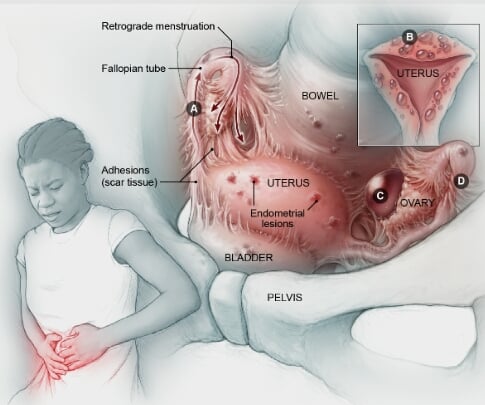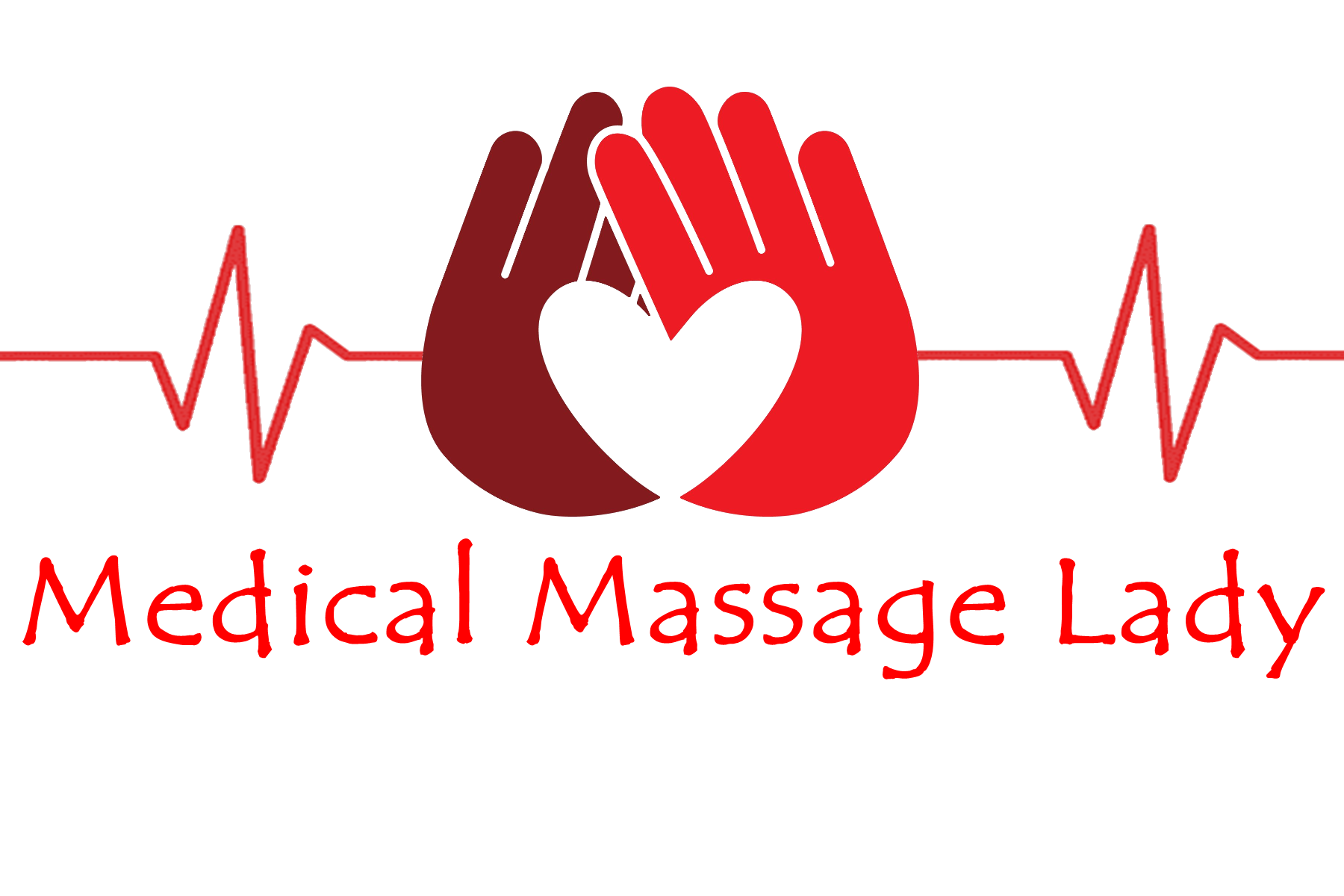- 07736 104738
- sam@medicalmassagelady.com
- Mon - Sat, 8:00 - 18:30
WHAT IS ENDOMETRIOSIS?
• excessive thickening & shedding of the lining of the uterus causing the endometrial cells to grow elsewhere in the body eg the fallopian tubes,ovaries,omentum,around the bowel,bladder & vagina. In very severe cases endometriotic tissue has migrated to the lungs, eyes & even the brain
• during the monthly hormone cycle changes the cells occur as they would in the uterus, in preparation for ovulation, but if the egg isn’t fertilised, the cells break down & bleed. The uterus has an exit route for this bleeding, but other areas of the body don't, causing internal bleeding,pain,inflammation & scar tissue formation, which pulls on other tissues, promoting the pain cycle.
• bleeding from endometriotic cells in the ovaries may form cysts which can cause severe ovulation pain
• fibrous adhesions form to help the body heal from the inflammation but they cause tissues to stick together, potentially causing lifelong issues
• besides the obvious physical symptoms, chronic fatigue & feelings of isolation & depression will seriously impact on relationships
• can cause fertility problems
CAUSES:-
The cause of endometriosis is not completely understood but suggested theories are:-
• retrograde menstruation ie.blood containing endometrial cells doesn't leave the body during a period but flows back through the fallopian tubes, causing cells to stick to the pelvic walls & organs, where they grow & continue to thicken & bleed over the course of each menstrual cycle
• the induction theory - hormones or immune factors promote transformation of peritoneal cells which line the inner abdomen, into endometrial-like cells
• embryonic cell transformation - hormones may transform embryonic cells into endometrial-like cells during puberty
• surgical scar implantation - after a surgery eg.hysterectomy or C-section, endometrial cells may attach to a surgical incision
• endometrial cell transport - blood vessels or lymph fluid may transport endometrial cells to other parts of the body
• immune system disorder- may inhibit the body's ability to recognize and destroy endometrial-like tissue that's growing outside the uterus

RISK FACTORS:-
• never giving birth
• menstruating from an early age
• menopause at an older age
• short menstrual cycles — less than 27 days
• heavy periods lasting longer than 7 days
• high levels of oestrogen in your body
• low body mass index
• genetic link - one or more relatives with endometriosis
• any medical condition preventing the normal passage of menstrual flow out of the body
• reproductive tract abnormalities
COMPLICATIONS:-
• infertility & impaired implantation - Approximately 33-50% of women with endometriosis have difficulty getting pregnant, due to the fallopian tube being obstructed, preventing insemination, or the sperm or egg being damaged. Since the condition tends to become progressively worse, trying to conceive early is advised. Laser removal of endometriotic tissue may improve chances of conceiving.
• higher incidence of ovarian cancer - although the overall risk of ovarian cancer is still relatively low
• rare endometriosis-associated adenocarcinoma — can develop later in life
SYMPTOMS:-

• unbearable, persistent pelvic pain, in addition to cramps, which may increase over time
• painful periods - pain may extend outside the days of bleeding
• lower back & abdominal pain
• pain during & following intercourse
• pain with bowel movements or urination, particularly during a period
• excessive bleeding - heavy periods/flooding, bleeding between periods
• infertility
• chronic fatigue
• diarrhoea, constipation, rectal bleeding, bloating, nausea, particularly during periods
• pain around the upper thighs and groin, sometimes with numbness
• coughing blood – in rare cases of endometriotic tissue in the lung
TREATMENT:-
Treatment aims to reduce the symptoms, improve fertility & prevent progression of the condition.
The form of treatment depends on the severity, age & whether you want to conceive.
Surgery may remove endometriotic tissue & provide relief for years, but increases the risk of scar tissue & the endometriotic cells will often grow back.

Surgical:-
-carries risks of anaesthetic, infection, bleeding, scar tissue
• laparoscopy – to confirm diagnosis of endometriosis. This will show lesions which fall into 3 categories o endometriomas - affect the ovaries o superficial lesions o deep infiltrating endometriomas. Peritoneal lesions may look red, brown, blue, black, or white and scar-like, & patches of such tissue may be surgically removed to improve symptoms & fertility
• adhesiolysis – divides the adhesions but the surgery itself will cause scar formation promoting a cycle of surgery-adhesions-surgery. 55% - 100% of women develop adhesions after pelvic surgery
• Hysterectomy – last resort
Non-surgical:-
• Painkillers
• hormone medication eg.contraceptives to reduce/stop menstruation
• intra-uterine coils can make periods lighter as not as many cells will form, but this may not effect other endometrial deposits
Holistic Treatment Options:-
• Aromatherapy – can have analgesic & anti-inflammatory properties, can use in massage or baths.
- Try mixing 10ml of base oil eg.olive oil with :-
1 drop of ginger (pain relieving & warming; boosts blood flow)
2 drops of grapefruit (a mild diuretic, eases swelling & fatigue, antispasmodic: relieves cramps)
1 drop of Bergamot (improves mood, calms the mind & aids digestion)
1 drop of Clary Sage/Juniper/cypress if in week of period (antispasmodic & encourages normal menstrual flow) to ease heavy flow, sooth cramps & stress.
• Massage - gently breaks down adhesions & scar tissue through frictions
- lymphatic drainage methods to flush stagnant fluid/toxins & distribute proteins & vitamins throughout the tissues
- petrissage improves blood flow & nutrition into the muscles
• Acupressure/acupuncture – working on points relating to the reproductive system may remove blockages restricting circulation, & help break down scar tissue & adhesions
Home remedies:-
• heat – helps relieve pain from pelvic muscle cramps (hot water bottle/bath/compress)
• pelvic massage – ideally just before period begins, may help reduce menstrual pain
• anti inflammatories eg. ibuprofen
• turmeric – acts as an anti-inflammatory & can inhibit oestradiol, hence reduce endometrial growths
• dietary changes eg.reducing inflammatory foods such as dairy, sugar, red meat, gluten & processed food & increasing fruits, vegetables, whole grains & omega 3 fatty acids which reduce inflammation
• regular light exercise - helps to release endorphins which may reduce pain & oestrogen levels
• rest – particularly during menstruation, lying on the side with the knees pulled into the chest may relieve pain & pressure in the back
MASSAGE
The aim of massage is to relax the nervous system, improve blood & lymph flow & reduce smooth muscle holding patterns without pulling adhesions apart, in order to help even women who have scar tissue from surgery or are in the later stages of endometriosis, whose organs may be stuck together. The bonds that attach collagen fibres to each other reduce when placed under sustained pressure over time, hence massage can reduce adhesions, decrease pain, & improve soft tissue mobility.
Since ablation & adhesiolysis are generally not permanent solutions, & hysterectomy is a last resort, massage has become a non aggressive treatment for treating the symptoms & potentially delaying the need for surgery, thus improving quality of life, not only in terms of physical health, but also mental health, independence, social interactions & being able to take care of the family.
BENEFITS OF MASSAGE IN ENDOMETRIOSIS
• reduces uterine spasms & pelvic pain
• reduces adhesions
• helps to increase fertility (due to adhesions & dysfunction in their reproductive organs)
• reduced pain during intercourse (research shows 50% of women experience full resolution of dyspareunia after 12 months)
• improved sexual function (orgasm, desire, arousal, lubrication, satisfaction)
• improves lymph & blood circulation, transporting nutrients & oxygen to affected tissue
• relaxes the nervous system
• reduces production of cortisol & norepinephrine (stress hormones) & increases serotonin , dopamine & oxytocin which enhance mood & reduce pain
• helps to ease pelvic congestion – during flare up of endometriosis symptoms, lower back muscles may go into protective spasms, which then increase abdominal & pelvic tension. Manipulation of these soft tissues can reduce these spasms & therefore reduce pain
TYPES OF MASSAGE FOR ENDOMETRIOSIS:-
SWEDISH MASSAGE - promotes overall relaxation, helps to improve circulation, alleviate muscle tension & improve the body's range of movement
MYOFASCIAL RELEASE - massage form that also involves stretching to work on the connective tissue that surrounds organs & muscles, breaking down scar tissue & adhesions
NEUROMUSCULAR MASSAGE - deep tissue massage which releases tension in trigger points thus reducing pain
FERTILITY ABDOMINAL ACUPRESSURE - manipulates the abdomen to detoxify the system & improve blood flow to the organs, thus improving the lining of the uterus. It can also help relieve painful periods and intercourse
Research shows that massage is most effective when carried out as one session between period & ovulation, & two between ovulation & the next menstrual cycle for three months. It may take up to around 2 weeks after treatment for the body & pain levels to start to adjust, but the benefits should really be seen after 6 weeks.
Massage is a safe way to treat endometriosis, but it is important to find a massage therapist who understands the condition & has experience in this area.




